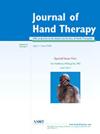手工淋巴引流对腕管综合征患者正中神经水肿的影响:一项随机对照试验
IF 2.1
4区 医学
Q2 ORTHOPEDICS
引用次数: 0
摘要
背景:神经水肿是腕管综合征(CTS)病理生理的重要因素。手工淋巴引流(MLD)是一种广泛用于治疗各种情况下水肿的手工治疗方法。目的评价MLD对CTS患者正中神经神经内水肿的影响,以及对症状严重程度和手功能的影响。研究设计:随机对照研究。方法选取轻中度双侧CTS患者27例,年龄48.9±9.9岁。随机将每名受试者的一只手分配到实验组,另一只手分配到对照组。实验组分别接受MLD、肌筋膜释放(MFR)治疗和常规物理治疗(CP)。对照组给予假MLD、MFR和CP治疗,干预措施每周2天,连续6周。应用电诊断技术评估正中神经远端运动潜伏期(DML)、运动神经传导速度(MNCV)和感觉神经传导速度(SNCV)。作为次要评估,评估握力、压痛阈、疼痛强度、症状严重程度和手功能。超声测量正中神经横截面积(CSA)。所有评估均在基线和干预后6周进行。结果经双向重复测量方差分析,实验组CSA改善明显(p <;0.001;η2 = 0.510), DML (p <;0.001;η2 = 0.549),感官(p <;0.001;η2 = 0.408),运动传导速度(p <;0.001;η2 = 0.419)比对照组大。两组间二次评价结果差异无统计学意义(p >;0.05)。结论mld可能通过减轻正中神经内水肿来缓解CTS症状。本文章由计算机程序翻译,如有差异,请以英文原文为准。
The effect of manual lymphatic drainage on intraneural edema of the median nerve in patients with carpal tunnel syndrome: A randomized controlled trial
Background
Intraneural edema is an important factor in the pathophysiology of carpal tunnel syndrome (CTS). Manual Lymphatic Drainage (MLD) is a manual treatment widely used to treat edema in a variety of conditions.
Purpose
This study aimed to evaluate the effect of MLD on intraneural edema of the median nerve in CTS patients, as well as its impact on symptom severity and hand function.
Study Design
Randomized controlled study.
Methods
Twenty-seven patients (aged 48.9 ± 9.9) with mild-to-moderate bilateral CTS were recruited for the study. One hand of each subject was allocated to the experimental group and the other hand in the control group randomly. The experimental group underwent MLD, myofascial release (MFR) therapy and conventional physiotherapy (CP). The control group received sham MLD, MFR and CP. Interventions were performed 2 days a week for 6 weeks. The distal motor latency (DML), motor nerve (MNCV), and sensory nerve (SNCV) conduction velocity of the median nerve were evaluated using electrodiagnostic techniques. As secondary evaluations, grip strength, pressure pain threshold, pain intensity, symptom severity, and hand functions were assessed. The cross-sectional area (CSA) of the median nerve was measured by ultrasound. All assessments were performed at baseline and 6 weeks after intervention.
Results
According to the analysis of a two-way repeated measures of ANOVA, the experimental group showed greater improvement in CSA (p < 0.001; η2 = 0.510), DML (p < 0.001; η2 = 0.549), sensory (p < 0.001; η2 = 0.408), and motor conduction velocity (p < 0.001; η2 = 0.419) of the median nerve than the control group. There was no significant difference between the groups in the secondary evaluation results (p > 0.05).
Conclusion
MLD may contribute to symptom relief in CTS by reducing intraneural edema in the median nerve.
求助全文
通过发布文献求助,成功后即可免费获取论文全文。
去求助
来源期刊

Journal of Hand Therapy
医学-外科
CiteScore
3.50
自引率
10.00%
发文量
65
审稿时长
19.2 weeks
期刊介绍:
The Journal of Hand Therapy is designed for hand therapists, occupational and physical therapists, and other hand specialists involved in the rehabilitation of disabling hand problems. The Journal functions as a source of education and information by publishing scientific and clinical articles. Regular features include original reports, clinical reviews, case studies, editorials, and book reviews.
 求助内容:
求助内容: 应助结果提醒方式:
应助结果提醒方式:


